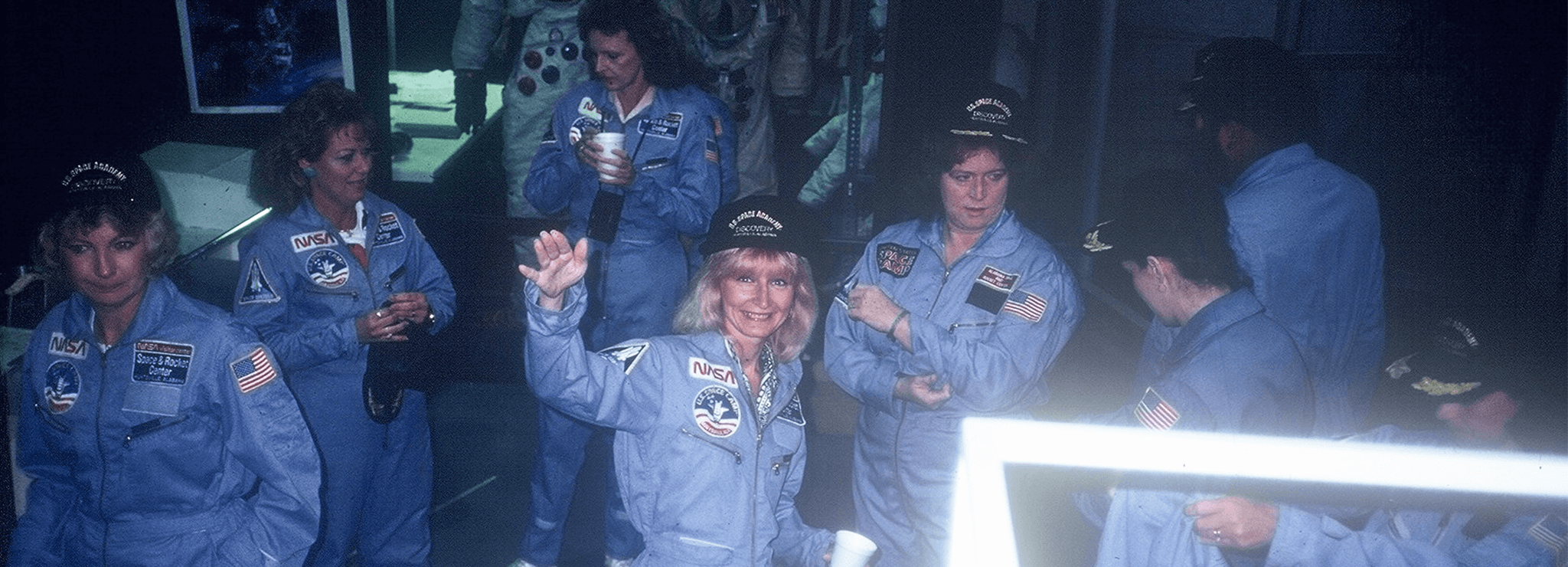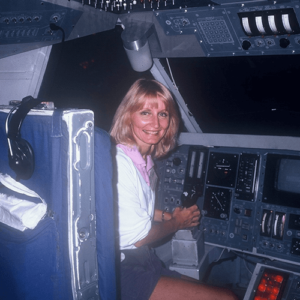Blogs | 5.22.2023
Support from Teacher in Space Participant Dr. Melanie Vickers

Dr. Melanie Vickers, a West Virginia educator for more than 40 years, remembers exactly where she was in August 1984 when President Reagan announced that a teacher would be selected to fly on a space mission as part of NASA’s Teacher in Space Project.
She lept from her couch where she was grading papers and dove into the lengthy application process. The following spring, her principal shared that out of 11,000 applications, she’d been chosen as a finalist from West Virginia to continue in the selection process. That summer, alongside Christa McAuliffe and 112 other nominees, Melanie participated in a week-long space education workshop to vie for a seat on the mission. While she wasn’t selected as one of the 10 finalists for the opportunity, it didn’t stop her in her mission to educate the next generation of explorers.
 Today, Melanie serves as a Space Ambassador and member of the West Virginia Civil Air Patrol and speaks to classrooms, businesses, teacher organizations, and civic groups about the importance of keeping the door to the future open for our children through Challenger Center and other space-related opportunities.
Today, Melanie serves as a Space Ambassador and member of the West Virginia Civil Air Patrol and speaks to classrooms, businesses, teacher organizations, and civic groups about the importance of keeping the door to the future open for our children through Challenger Center and other space-related opportunities.
We sat down with Melanie to ask her about her incredible career as an educator and why Challenger Center matters to her . . .
Were you interested in STEM subjects when you were a child?
As a child, I struggled to sit still in class. I stayed outside as long as I could, running, riding bikes, climbing trees, and looking for fireflies. My interest in science was because of my 7th-grade science teacher, Mr. Gutierrez. He took his students outdoors and showed us how to learn right in our backyards. It ignited my type of learning. Mr. Gutierrez taught us how to work in a team, observe, problem solve . . . all the things that Challenger Center is built on and that need to be taught to every generation.
How did you first get involved with Challenger Center?
On January 31, 1986, I attended the memorial service for the Challenger crew at Johnson Space Center in Houston, Texas. Our entire class stood together listening to President Reagan say, “The Challenger crew was pulling us into the future, and we’ll continue to follow them.” As I flew home, I thought about how the children in West Virginia had watched the tragedy unfold in real-time. They would be looking to me, and to all their teachers and adults, to see how we reacted. I had the opportunity to teach an important lesson, but I needed help.
Together with a friend and fellow teacher, Terilyn Wilson, we came up with the idea to involve West Virginia’s schoolchildren in memorializing the tragedy by donating pennies to build a statue of our hero, Christa McAuliffe. Over the course of a year, with lots of connections and partnerships, we unveiled the West Virginia Pennies for Christa Project with a statue in Charleston, West Virginia.
As time went on, I read that the families of the Challenger crew had created Challenger Center to honor the memory of the crew and to continue their educational mission. I immediately supported Challenger Center and continue to do so to this day. As I reflect, the teamwork that was necessary to pull together the West Virginia Pennies for Christa Project is similar to the steps students take when working together on a Challenger Center mission. We must all collaborate and work together to complete our missions.
What about Challenger Center makes you proud?
I’ve visited two Challenger Learning Centers over the years: Challenger Learning Center at Wheeling Jesuit University and Challenger Learning Center at the Christa McAuliffe Center. I’m particularly delighted with Challenger Learning Center at Wheeling for the 350,000+ students they’ve served, missions they’ve flown, and teachers they’ve trained since opening in my state of West Virginia nearly 30 years ago!
There isn’t a profession in the world that teachers haven’t been part of. Not everyone’s going to be an astronaut, but kids need to know how to sew spacesuits, or create medicines for space flight, or succeed in careers that haven’t even been invented yet. I’m proud to watch the work Challenger Center does to provide opportunities for students work together, learn in a hands-on environment, and see the possibilities they have in STEM.
What do you wish everyone knew about Challenger Center?
Challenger Center is for every child, especially the kids who don’t learn traditionally by sitting in a seat with paper and pencil. Challenger Center offers rich technology, hands-on programs that support 21st-century skills like team building, and opportunities for students to see all of the possibilities for their futures.
I believe all good things come to those who hustle while they wait. Everyone has dreams, but you have to act on them. Work on small things to get you closer to your dream, so you’re prepared for your opportunity. Maybe the kids visiting a Challenger Learning Center won’t know yet what their dream is, but we’re preparing them for their dreams and future opportunities. We open the door to their futures.
What motivates you to continue supporting Challenger Center?
 Space exploration improves the quality of life on Earth. We go to space so we can make our world a better home. Our children are the next generation of space explorers.
Space exploration improves the quality of life on Earth. We go to space so we can make our world a better home. Our children are the next generation of space explorers.
Everyone has had a teacher who touched their lives, and every member of my NASA Teacher in Space Class were phenomenal people. I felt like I was out of my league—every teacher in this group was dedicated, caring, and accomplished.
As an educator, I love Challenger Center because we’ve put Christa’s Lost Lessons online. Her legacy lives on because Challenger Center made it accessible to teachers and students. The future sits in our classrooms every day.
Join Melanie in our mission
Thank you so much for sharing your story, Melanie! If you’d like to join Melanie and become a Challenger Center supporter, visit www.challenger.org/donate to give today and help us inspire millions more students.
